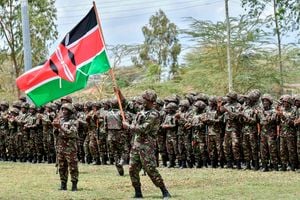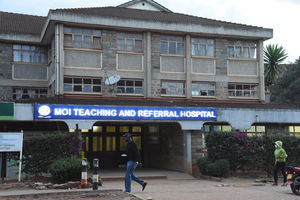Dangers lying ahead on Mt Kenya’s path

Voters queue at Muigariua polling station during the Kandara parliamentary by election on January 5, 2023.
What you need to know:
- The total population of Murang’a as at the 2019 census was about 1 million.
- Murang’a registered voters in 2022 were about 660,000.
- A declining population also reduces the region’s political significance.
Having lived in and observed Mt Kenya region for a long time, I can make some important points about the region that might as well speak to the rest of Kenya.
The first danger facing the Mt Kenya region is falling demographics. Fewer and fewer children are being born. It is becoming a region for the elderly. That's contrary to Kenya’s general demographic outlook whose median age is in the 20s.
Various datasets attest to this. For instance, the total population of Murang’a as at the 2019 census was about 1 million. But registered voters in 2022 were about 660,000. Assume about 50,000 adults did not register to vote.
That means the Murang’a adult population is about 700,000 and with at least 300,000 minors. The population pyramid is inverted. Between 2009 and 2019, the population growth of Murang’a was insignificant. This stagnation of population applies in all Mt Kenya counties, explaining skyrocketing of lifestyle diseases associated with the elderly — like diabetes and hypertension.
Perhaps that is also why Mt Kenya politics is around older people. Sonkoism — the flashy youth oriented politics — struggles to sell in the region since older people outnumber the youth.
A declining population also reduces the region’s political significance. The workforce also shrinks, forcing the importation of labour. Other possible consequences include reduction of economic activities as young people are the ones who power economies and create a base for taxation.
The second danger lies in the region’s failure to adequately align its future to changing economic patterns.
The world economy is changing towards an automated future. But a keen look at IT sector reveals Mt Kenya is not adequately represented in that futuristic world. Its sons and daughters seem to have got education in sectors that do not guarantee work for the future. There is a lot of handholding and inspirational stories in some regions that encourage the younger generation to take up IT.
In Mt Kenya, the success stories lie elsewhere, mostly on yesteryear’s industries.
Connected to this are the education standards. The decision by the Jubilee administration to ban the ranking on national exams results may have had some merits but it makes it hard to compare the performance of schools in Mt Kenya against other regions. In the 1980s, Nyandarua (followed in quick succession by other Mt Kenya counties) used to rank first in KCPE results.
The third danger lies in the fast decline of Mt Kenya culture, in particular its local languages. Language is the most important marker of a community.
A large proportion of modern Mt Kenya children do not speak local languages. When they grow up they might not identify themselves as Mt Kenya natives, which could affect voting in cosmopolitan areas like Nairobi where a majority have their roots in the region but are “de- kikuyunised” Kikuyus.
This generation of children is what Joseph Kamaru in his 1960s song " Ndanuko Cia Mitahato" meant when he sang " Do not feel ashamed when you take your children to the rural areas . And your children ask you, this dog that is eating sweet potatoes vines is of what breed?" (They confused a goat for a dog).
The fourth danger lies in the region’s state of the family unit, in particular the boy child. There is a constant Mt Kenya outcry of alcohol abuse, which must be tackled. But declining job opportunities is the root cause of this sad state of affairs. A people primed from childhood to join white collar jobs through education, makes it hard to pivot back towards the blue collar sector as adults. And jobs for young males are on the decline — males thrive in manufacturing, a sector that has not been expanding. The transport sector (like boda boda) remains dangerous. Girls are primed to care and hence their sectors — like teaching and nursing — grow.
There are no easy remedies. For instance, birth rates are following a universal trajectory linked to rising educational standards — especially among women — and urbanisation. A rural existence tends to incentivise people to have more children but opposite factors are at play within an urban setting.
Decline of Mt Kenya languages is also a factor of globalisation. However, educational outcomes plus male child problems can be mitigated even if not fully solved.
A concerted effort by various stakeholders including leaders that control resources to reward academic efforts might help. Bursaries that target merit as opposed to cronyism are also important. Mt Kenya needs to ignore some national policies on education like tuition bans — tuition actually helps. Also, encouraging children to take up science and technology courses will help bridge knowledge gaps.
On male-child issues, work-study programmes that target males, particularly in embedding skills are needed.
Most importantly, Mt Kenya counties should have policies that attract industry and manufacturing. They must refocus towards industries that are moving towards the Mombasa Road/ Kajiado/ Machakos belt.
A clever strategy to move them towards Kiambu/Muranga/Nyeri belt should be devised. That will offer Mt Kenya males better and stable jobs.
For the Kikuyu language to survive, it should be made the language of science and knowledge. Biology, physics, IT, mathematics should have Kikuyu translations otherwise it will only be lingua franca for social interaction and at a certain stage, it will give way. Further, it needs to be internationalised. Singapore’s bi-lingual policy of promoting English and Chinese is now making sense after the rise of China economically.
Kenya is “internationalising” and many youth are being encouraged to seek opportunities abroad. Mt Kenya should seriously explore this new frontier.
Finally, even as we plan for the Youth, let the region plan for its elderly, the largest share of its population, particularly on healthcare.
Dr Kang’ata is the Governor of Murang’a County; Email [email protected].





